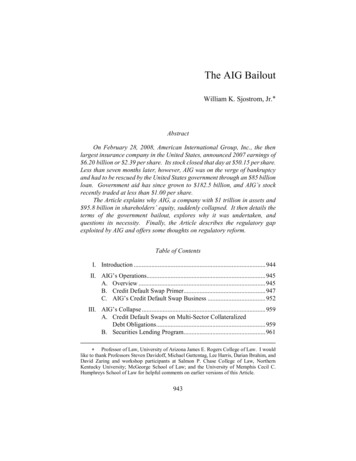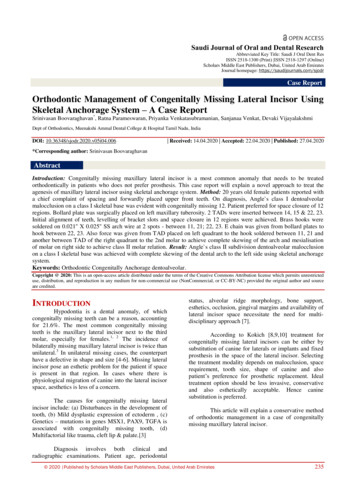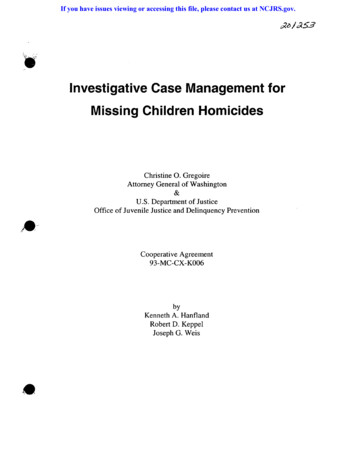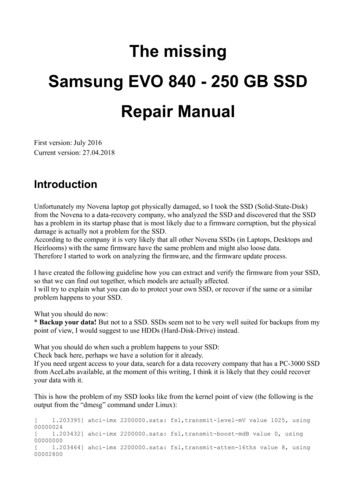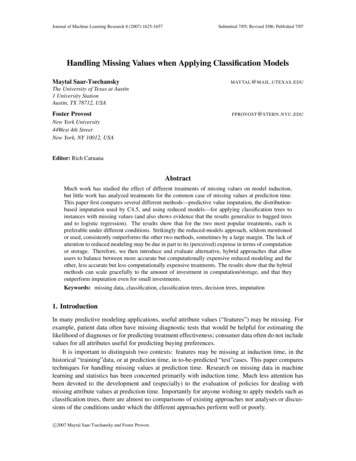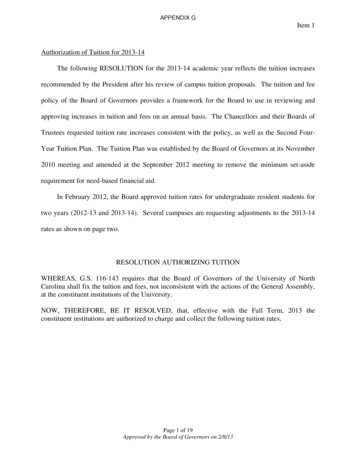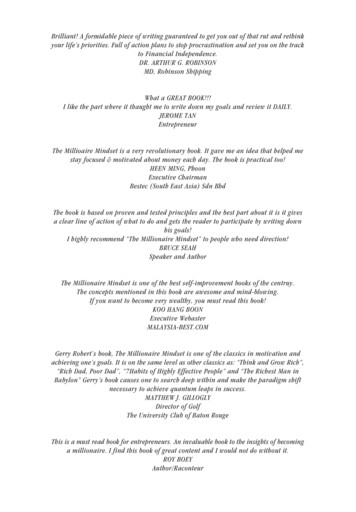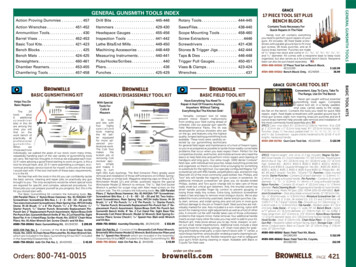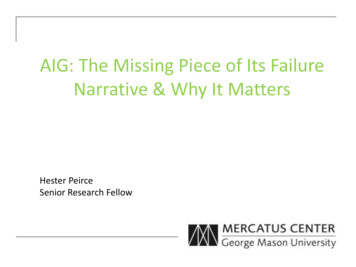
Transcription
AIG: The Missing Piece of Its FailureNarrative & Why It MattersHester PeirceSenior Research Fellow
Why Should We Care? AIG was one of the biggest bailout events ofthe crisis. 182.3 billion was made availableto AIG. We should know why it happened. Better understanding what happened at AIGwill help us to think about what reformsshould or could be made to prevent a repeat.
Today’s Agenda What got AIG in trouble? Why did government intervene? Did Dodd-Frank reforms addressthe problems at AIG?
The Standard View of AIG’s Downfall “AIG Financial Products, operatingout of London, brought down thecompany and nearly toppled the U.S.economy.” Gary Gensler, former ChairmanCommodity Futures Trading Commission, May 2012
Alternate View “AIG blew up when its stocklending shadow bank – aninsurance company – suffered arun.” Paul Tucker, Deputy Governor Financial Stability,Member of the Monetary Policy Committee and Member of theFinancial Policy Committee, March 13, 2012
The Making of AIG Founded by Cornelius Vander Starr in 1919 in Chinaas insurance company Expanded into other business lines 130 countries 116,000 employees 76 million customers Maurice “Hank” Greenberg—CEO for nearly 4decades—presided over much of growth
AIG Post-Greenberg March 2005: Martin Sullivan, a companyinsider, took over as CEO February 2006: AIG paid over 1.6 billion tosettle with DOJ, SEC, and NY on accounting,bid rigging, and workers comp charges. June 2008: Company was losing money fast.New CEO Robert Willumstad came in toreplace Sullivan
AIG’s Business UnitsGeneral InsuranceLife Insurance & RetirementServicesFinancial ServicesAsset Management
AIG’s Hundreds of RegulatorsAIG entityRegulatorAIG Holding CompanyOffice of Thrift Supervisiondomestic insurance companiesstate insurance regulatorsforeign insurance companiesAIG Federal Savings BankAIG Securities Lending Corp. (after registering as brokerdealer in 2006)AIG’s European operationsforeign insurance regulatorsOffice of Thrift SupervisionSecurities and Exchange Commission/Financial Industry Regulatory AuthorityFrench Commission Bancaire (coordinating supervisor)
Origins of AIGFP 1987: AIG enters into joint venture withdefectors from Drexel Burnham Lambert Howard Sosin, the original CEO, clashed withHank Greenberg His successor, Tom Savage, had a keygoverning principle. . .
Mortgage-Related Assets
In 2002, Joe Cassano took over
Mortgage-Related Assets
Credit Default Swaps A CDS is an over-the-counter derivative As a derivative financial product, it derives itsvalue from something else—for CDS bonds People use CDS to manage risk AIG sold different kinds of CDS AIG, with its strong credit-rating was anattractive counterparty
AIGFP’s CDSCorporateArbitrage CDSRegulatoryArbitrage CDSMulti-SectorCDO CDS
Collateralized Debt Obligations Investment-grade security backed by a pool ofbonds, loans and other assets with varyinglevels of risk. CDOs bundle the various typesof debt into tranches of distinct maturities andrisk levels, including tranches made ofsubprime loans.--Federal Reserve Bank of New York
What Was In Those CDOs?Lots of ResidentialMortgage-BackedSecurities
Was Joe Cassano a Fool or a Sage? Normally, CDS dealers protect themselves byhedging their exposure AIGFP did not hedge; it sold a lot of CDS; itwas on one side of the market Joe Cassano insisted that he had hedged hisexposure by only offering protection on thesuper-senior tranche of the CDOs
AIG’s Super-Senior CDS“super senior” risk layer(AIGFP net notional exposure)AIGFP attachment BBBBBequityportfolio made up oftranches of securitizedresidential andcommercial mortgages,auto loans, etc. andfurther separated intotranches
What CouldPossibly GoWrong?
Goldman Sachs Could Call
Collateral Calls at AIGFP Starting in August 2007, Goldman and othercounterparties began asking AIGFP to put upcash margin—essentially a pledge that it couldmake good if it had to AIGFP fought back; the collateral calls werearguably aggressive and were based on verylittle pricing data
Unrealized Losses on AIG’s Super-Senior CDS908070billions of dollars6050net notional valuecumulative fair value loss40302010012/31/073/31/086/30/089/30/08
AIGFP Could Have Been Much Worse AIGFP stopped writing CDS on multi-sectorCDOs in early 2006—before the housingmarket saw its darkest days. AIGFP based the decision on concern that themortgage market was spiraling out of control. But AIGFP did not make serious efforts tohedge its existing CDS positions.
One Part of AIGDid Not Get theMemo
What Is Securities Lending? One party lends a stock, bond, or othersecurity to another & receives cash or othercollateral. Hedge funds & broker-dealers borrow forshort-selling & other trading strategies. Life insurance companies, mutual funds &other holders of large pools of securities lend. Loans are usually very short-term—may rollover daily.
What Is Securities Lending? Borrower typically posts excess collateral—usually 102% to 105%. Collateral is adjusted through term of loan. Lender gives a rebate to borrower, the size ofwhich depends on the scarcity of the securitybeing lent. Lenders make money by reinvesting the cashcollateral in low-risk investments.
How Securities Lending Works
AIG’s Securities Lending Program AIG set up a joint program for its life insurancesubsidiaries. The subs pooled their securities and lent themout in exchange for cash. AIG’s loans were unusual in that many werefor fixed one-month terms.
AIG's Approximate Share of Worldwide Cash CollateralReinvestments During CrisisRest of worldAIGBased on data from: Matthew Dive et al., Developments in the Global Securities Lending Market,BANK OF ENGLAND QUARTERLY BULLETIN 224, 228 (3rd Quarter 2011),available at nts/quarterlybulletin/qb110303.pdf.
Growth of AIG’s Securities Lending Program90securities lending payable(billions of 2/31/0412/31/0512/31/0612/31/07
ResidentialMortgageBacked Securities
Collateral Reinvestment80cash and ot ratedbillions of dollars60MBS/ABS/collateralized A50MBS/ABS/collateralized AA40MBS/ABS/collateralized AAA30corporate debt BBB/not ratedcorporate debt A20corporate debt AA10corporate debt AAA012/31/073/31/086/30/089/30/08 AIG wasmuchmoreheavilyinvestedin MBSthantypicalseclender.
Difference Between Sec Lending Payable & Reinvested Collateral181614 -07Jun-07Sep-07Dec-07Mar-08Jun-08Sep-08
Why Was This a Problem? Securities lending transactions are short-term;they often get rolled over, but the borrower isunder no obligation to renew. When borrowers wanted their cash back,there wasn’t any—it was all tied up in RMBS. The program reached its peak at 94 billion inOctober 2007 as AIG used proceeds from newloans to repay old ones.
Everything is fineuntil Borrower 2wants its cashcollateral back.
The Crisis Spelled Trouble for AIG In addition to making new loans to repay oldones, AIG was selling any of the securities inits reinvestment portfolio it could sell, butthose securities were not hot sellers duringthe crisis. In 2008, things got worse because borrowers,along with everyone else, really wanted onething . . .
CASH!
Haircuts Made Matters Even Worse
Securities Lending Haircuts The standard in securities lending is togive the lender 102%-105% of thesecurity’s value. When securities borrowers started to getthe upper hand in 2008, they only paid100%. Then 98 . . . 95 . . . 80 . . . 73 %.
If AIG Didn’t Repay . . . Borrower could sell securities Borrower could go after assets of participatinglife insurance companiesAIG contributed money to the securities lendingpool to make up for undercollateralization andlosses on securities sold.
AIG’s Income and LossesReporting periodNet income (loss), billions of dollars20049.84200510.48200614.051st quarter 20074.132nd quarter 20074.283rd quarter 20073.094th quarter 2007(5.29)1st quarter 2008(7.81)2nd quarter 2008(5.36)3rd quarter 2008(24.47)4th quarter 2008(61.66)
AIG’s Stock Price Reflected the Grim State ofAffairs 1,400 1,200 1,000 800 600 400 200 01/1/075/15/089/27/092/9/116/23/12
AIG’s Credit Rating Was a Real WorryCredit RatingAgency DowngradeMore Demands forCollateralAIG ‘sability toraise capitaldiminished
Sec Lending Kept New CEO Awake at Night A problem coming from insurance subsidiarieswould have caused AIG reputational damageand regulatory issues. But, AIG did not have cash to spare. In June 2008, when he started as CEO,Willumstad quickly realized that securitieslending would be a problem—a liquidity drain He went to visit . . .
Think back to 2008 March 2008: Government subsidized J.P.Morgan’s purchase of Bear Stearns. September 2008: Government takes overFannie and Freddie. September 13-14, 2008: Lehman weekend. September 15, 2008: Lehman files forbankruptcy.
Lehman Weekend AIG Weekend As Lehman’s fate was being decided, so toowas AIG’s. No private sector solution materialized—WallStreet firms that went in decided AIG neededmore money than its assets were worth. Insurance regulators tried to cobble togethera quick deal that effectively would use P&Ccompanies to rescue life insurance companies.
Why Rescue AIG? Could markets handle another bigfailure? What would insurance customers do? What about AIG’s manycounterparties? Would European banks be hurt?
Fed to the Rescue 85 billion revolving credit facility from theFed under Section 13(3) Authority of theFederal Reserve Act. Collateralized by AIG’s assets. Government got preferred stock convertibleinto 79.9% of AIG. Terms of loan were tough: LIBOR 8.5%.
AIG Spending Rate Was Alarming AIGFP counterparties were stillasking for money. Securities lending borrowersasked for 24 billion betweenSeptember 12 and 30, 2008.
When It Runs Out, Re-Bailout October 2008: Fed sets up a 37.8 billionprogram to step into shoes of fleeingsecurities lending counterparties. AIG coulduse cash from Fed to repay counterparties. November 2008: TARP funds were injectedand Maiden Lane II and III are set up.
Maiden Lane Off-Balance Sheet Entities Maiden Lane II To take care of AIG’ssecurities sendingproblem 19.5 billion fromgovernment 1 billion from AIG AIG’s securitieslending counterpartieswere paid off Maiden Lane III To take care of AIGFP’sCDS problem 24.5 billion fromgovernment 5 billion from AIG Purchased underlyingCDOs from AIG’scounterparties
AIG Payments to Counterparties:September 16-December 31, 2008AIGFP54%securities lending46%
In contrast to Lehman, the core operations of AIGwere viable and profitable insurance companies.AIG’s financial difficulties stemmed primarily fromthe loss of liquidity to fund collateral calls on itsunhedged derivatives positions in one part of thecompany—its Financial Products Division.--Federal Reserve Chairman Ben Bernanke,November 2010
Were the Insurance Subs Healthy?Source: DAVID MERKEL, TO WHAT DEGREE WERE AIG’S OPERATING INSURANCE SUBSIDIARIES SOUND? 4 (2009),available at g%20Subsidiaries%20Sound.pdf
Year-End Statutory Surplus and Statutory Net Income at AIG’s Life-Insuranceand Retirement-Services Subsidiaries (millions of dollars)Statutory net income(loss)YearStatutory surplus2006 35,058 5,0882007 33,212 4,4652008 24,511( 23,558)
Insurance Regulation Insurance companies are regulated by states inwhich they sell insurance. Insurance regulators had authority to intervene insecurities lending matters. To avoid conflicts, state regulators coordinatethrough the NAIC. Insurance companies have to maintain a certainlevel of capital. When an insurance company runs into trouble,state regulators wind it down.
Risk-Based Capital System200% and aboveRatio BasedCapitalNointervention150% and aboveCompanycorrectiveplan100% and aboveRegulatorexams andanalysis70% and aboveLess than 70%Regulator maytake controlRegulatormust takecontrol
AIG's Largest Domestic Life Insurance/Retirement Services Companies: Regulatory Capital and RelatedEventsSource: GAO Sept. 2009 Update, supra note 207, at 77 (Figure 12).Adjusted capital (2007) 23,116 25,000Control level risk-based capital (2007) 20,040 20,000Adjusted capital (2008) 15,653 15,000Control level risk-based capital (2008) 10,000 5,000 2,901 2,474Net income / loss (2008) (52)Unrealized capital losses (5,000) (10,000)Capital contributions (15,000) (20,000) (25,000) (17,602)Stockholder dividends (24,214)
Why Did Securities Lending Losses Matter? AIG’s life insurance subsidiaries were introuble in the fall of 2008. Their troubles were placing real liquidity andcapital demands on the AIG parent. If the Fed had not engineered a bailout, AIGwould have filed for bankruptcy and some ofthe life insurance companies would likely havebeen seized by state regulators.
Why Not Bankruptcy for AIG? Allowing AIG to fail would have: Taught a meaningful lesson to other companies.Careful centralized liquidity and risk managementis important. Provided regulatory consistency. Lehman wasallowed to fail because it was insolvent. AIG wasinsolvent too. Even after AIG’s initial rescue, government couldhave allowed bankruptcy.
What Does Adding the Securities Lending Piece of theStory Tell Us? Regulation is not the answer. The lifeinsurance companies were heavily regulatedby the states. There is no basis for assuming that the Fedwill do a better job than the state insuranceregulators did at monitoring risk-taking. AIG is not the poster child for Dodd-Frankderivatives reform that some have suggestedit is.
What Should We Do? People care about risks when their money ison the line We need to look for ways tomake shareholders and creditors bear losseswhen things go badly. We need to make sure that bailouts are not anoption. Make bankruptcy work for large financialcompanies.
AIG Bailout: Investment Success? Yes, if simply getting paid back is success. In thatcase, I’d like to borrow 100 from you today. I’ll payit back in 5 years. No, if we consider opportunity costand risk. Lots of companies were looking for cash in 2008. Private consortium had decided AIG was lousyinvestment. If gov’t is playing investor, it has to consider riskreward tradeoff. We could have earned a betterreturn on a lower-risk investment.
Hester Peircehpeirce@mercatus.gmu.edu703-993-4941This presentation is based on a working paper, which is available ing-and-untold-story-collapse-aigSource information is available in that paper.
Credit Default Swaps A CDS is an over-the-counter derivative As a derivative financial product, it derives its value from something else—for CDS bonds People use CDS to manage risk AIG sold different kinds of CDS AIG, with its strong



